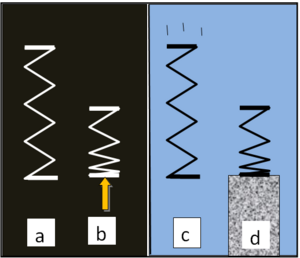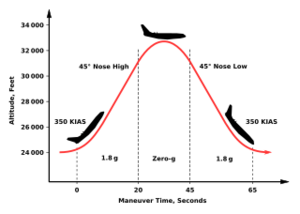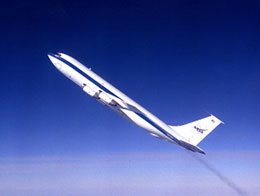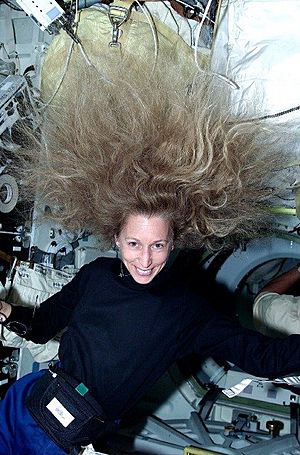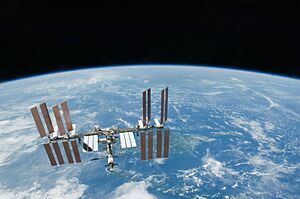Weightlessness facts for kids
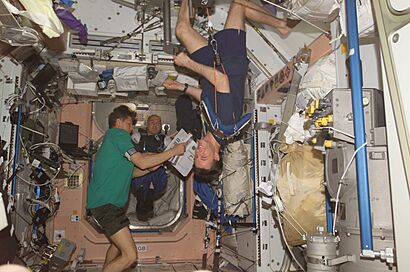
Weightlessness means you feel like you have no weight at all. It's also called zero-g or microgravity. This happens when the forces pushing on you, like the floor or a chair, are gone. It's not truly "zero gravity" because gravity is always there, but you don't feel its pull in the usual way.
A microgravity environment is very similar. It means the forces of gravity are extremely small, but not exactly zero. This is what astronauts experience on the International Space Station (ISS).
When you stand on Earth, you feel your weight because gravity pulls you down, and the ground pushes back up. But in space, things are different. Even though gravity is still pulling on a spacecraft, it's also moving so fast sideways that it keeps "falling" around the Earth instead of crashing into it. This constant falling motion makes everything inside feel weightless.
Contents
How Weightlessness Works
When astronauts feel weightless, it's not because there's no gravity. Gravity is still there, pulling on them and their spacecraft! Instead, it's because they are constantly falling around Earth. Think of it like this:
Imagine you are in an elevator, and its cable breaks. As the elevator falls, you would feel weightless because you and the elevator are falling at the same speed. This is similar to what happens in space. The spacecraft and everything inside it are always falling towards Earth, but they are also moving very fast sideways. This makes them fall *around* the Earth, staying in orbit.
Space journalist James Oberg explains it well: Satellites stay in orbit because of their huge speed. They are always being pulled by Earth's gravity, but they fall "over the horizon." The Earth's curved surface moves away as they fall, keeping them in orbit. So, it's speed, not a lack of gravity, that keeps them up there.
Experiencing Weightlessness on Earth
It's possible to experience a feeling of weightlessness without going into space!
Planes That Fly Like They're Falling
Since 1959, special airplanes have been used to create a nearly weightless environment. These planes are sometimes called "Vomit Comets" because the up-and-down motion can make people feel sick!
To make you feel weightless, the plane flies in a big, curved path called a parabolic arc. First, it climbs steeply, then it dives down. During the dive, the pilot controls the plane so that it acts like it's falling freely, just like a spacecraft in orbit. This gives you about 20-30 seconds of weightlessness at a time.
NASA's Weightless Wonder
NASA has used these planes since 1973. Their current plane, the "Weightless Wonder VI," is a McDonnell Douglas C-9. It's based in Houston, Texas.
NASA even has a program called "Microgravity University." It lets college students propose their own experiments to test in microgravity. If their idea is chosen, they get to fly on the "Vomit Comet" to do their research!
European Space Agency's Zero-G Plane
The European Space Agency (ESA) also uses a special Airbus A310-300 for similar flights. These flights are used for scientific research. They do "campaigns" where they fly three days in a row, with about 30 parabolas per flight. This gives scientists about 10 minutes of weightlessness each time.
Flights for Everyone!
In 2012, a company called Novespace created Air Zero G. They use the same A310 plane to let regular people experience weightlessness! About 40 passengers can go on each flight. These flights help promote space research and let people feel what astronauts feel. Even famous actors like Tom Cruise have used these planes for filming movies!
Another company, Zero Gravity Corporation, uses a modified Boeing 727 for similar public flights.
Drop Towers for Quick Weightlessness

Scientists also use tall towers or tubes to create weightless conditions on the ground. These are called drop tubes or drop towers.
NASA's Zero Gravity Research Facility in Ohio is a 145-meter (about 475 feet) deep shaft. An experiment can be dropped down it for 5.18 seconds, falling 132 meters (about 433 feet). It's like a very fast, short free fall!
Another one at NASA Glenn is the 2.2 Second Drop Tower, which is 24.1 meters (about 79 feet) tall. It's used for quicker tests.
Spinning Machines for Samples
Another way to simulate weightlessness, especially for biological samples like plants or cells, is with a "random positioning machine." This machine spins samples in two directions at once. This constant spinning averages out the pull of gravity, making the sample feel like it's in microgravity.
Weightlessness in Space
The International Space Station (ISS) is a great example of a microgravity environment. While astronauts feel weightless, there are still tiny forces at play. These come from:
- Tidal effects: Gravity is slightly stronger on the side of the ISS closer to Earth than on the side farther away. This creates a tiny pull.
- Air resistance: Even in space, there's a tiny bit of atmosphere. This causes a very small drag on the station.
- Astronaut movements: When an astronaut pushes off a wall, the station moves a tiny bit in the opposite direction due to conservation of momentum.
These effects are very small, which is why it's called "microgravity" (micro means very small).
Sub-Orbital Flights
Some rockets go into space but don't orbit Earth. These are called sub-orbital flights. They go up very high and then come back down. During the highest part of their flight, before they start falling back to Earth, people and experiments inside experience a few minutes of weightlessness. This is a good way to do short experiments in microgravity.
Deep Space Travel
To truly experience almost no gravity, you would need to travel very, very far away from Earth and the Sun. This is because the pull of gravity gets weaker the farther you are from a massive object. Only a few interstellar probes, like Voyager 1 and Pioneer 10, have traveled far enough to be in a region where the Sun's gravity is extremely weak. This kind of "zero gravity" is very hard to reach!
How Weightlessness Affects the Body

Our bodies are made for life on Earth with its gravity. When people spend a long time in weightlessness, their bodies start to change. Most of these changes go back to normal when they return to Earth, but some can cause long-term health issues.
Space Sickness
Many astronauts feel sick when they first go into space. This is called space adaptation syndrome or SAS, but it's often just called space sickness. Symptoms include feeling sick to your stomach, throwing up, headaches, and feeling tired. About 45% of astronauts get it. It usually lasts for a few hours to a few days, then your body gets used to it.
Muscles and Bones
One of the biggest problems in space is that muscles get weaker (muscle atrophy) and bones lose their density (spaceflight osteopenia). This happens because your muscles and bones don't have to work as hard against gravity.
To fight this, astronauts exercise a lot in space, like cycling or lifting weights. They also wear special pants with elastic bands to keep pressure on their leg bones.
Heart and Blood
In space, fluids in your body shift upwards towards your head because gravity isn't pulling them down. This can make astronauts' faces look puffy, like a "moon-face." Your heart also works less hard, and your body produces fewer red blood cells.
When astronauts return to Earth, their bodies have to re-adjust to gravity. This can make them feel dizzy or faint when they stand up, because their heart and blood system are used to the microgravity environment.
Scientists are always studying these effects to keep astronauts healthy, especially for longer missions to places like Mars.
Cool Things Done in Weightlessness
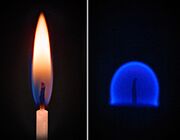
Growing Better Crystals
Scientists are interested in growing very high-quality crystals in microgravity. On Earth, gravity can cause flaws in crystals as they grow. In space, without gravity's pull, crystals can grow more perfectly. These super-perfect crystals could be used in advanced electronics or for studying how proteins work in our bodies.
For example, a medicine called Pembrolizumab was grown as crystals on the ISS. The space-grown crystals were more uniform, which could help make the medicine easier to give to patients.
-
Protein crystals grown by American scientists on the Russian Space Station Mir in 1995.
-
Comparison of insulin crystals grown in outer space (left) and on Earth (right).
Images for kids
-
Zero-gravity testing at the NASA Zero Gravity Research Facility
-
US astronaut Marsha Ivins demonstrates the effect of weightlessness on long hair during STS-98
-
The International Space Station in orbit around Earth, February 2010. The ISS is in a micro-g environment.
-
Astronaut Clayton Anderson as a large drop of water floats in front of him on the Discovery. Cohesion plays a bigger role in space.
-
Candle flame on Earth (left) versus in orbital conditions (right)
 In Spanish: Ingravidez para niños
In Spanish: Ingravidez para niños
- Artificial gravity
- Astronauts
- Astronaut training
- Commercial astronauts
- Clinostat
- Commercial use of space
- Effect of spaceflight on the human body
- ESA Scientific Research on the International Space Station
- European Low Gravity Research Association (ELGRA)
- G-jitter
- Microgravity University
- Reduced-gravity aircraft
- Scientific research on the International Space Station
- Space adaptation syndrome
- Space manufacturing
- Space medicine
- Vomit Comet


